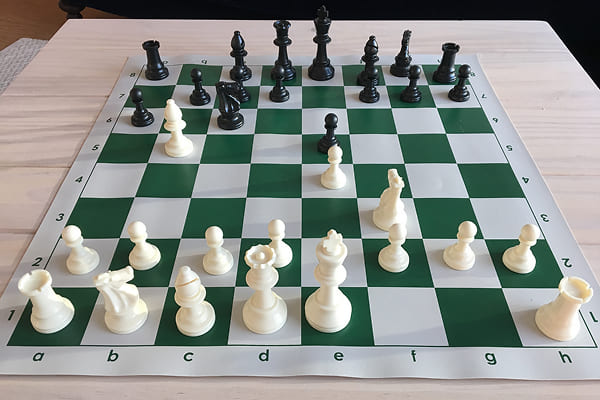Chess

Chess
A timeless game of skill, foresight, and mental resilience — respected across centuries and cultures.
Chess is a battle of minds — a game of complete information where every piece, move, and plan has meaning. Whether played casually at a café or competitively online, Chess offers endless depth and strategic challenge.
How to Play Chess
The goal of chess is to checkmate your opponent’s king — putting it in a position where it cannot escape capture. Here's the basic flow of play:
- Setup: Each player has 16 pieces: 1 king, 1 queen, 2 rooks, 2 bishops, 2 knights, and 8 pawns. White moves first.
- Piece Movement: Each type of piece moves in a unique way. Understanding movement is the foundation of strategy.
- Turns: Players alternate turns. Only one piece may be moved per turn (except during castling).
- Capturing: Pieces capture by landing on an opposing piece’s square, removing it from the board.
- Special Moves: Includes castling, en passant, and pawn promotion.
- Check: If your king is under threat, you must make a move to remove the threat.
- Checkmate: If no legal move removes the threat to your king, the game ends in checkmate.
- Draws: Games can also end in a draw by stalemate, repetition, insufficient material, or agreement.
➤ Full notation and advanced rules are covered in our extended strategy guide.
Core Mechanics
Chess is driven by strategic planning, tactical calculation, and positional control. Here are its foundational mechanics:
🔍 Perfect Information
There’s no hidden data — both players see the entire board. It’s a mental duel of open intentions and subtle traps.
♟️ Asymmetric Movement
Each piece behaves differently. Strategy begins with understanding these movements and combining them effectively.
🏰 Control of the Center
Owning central squares gives you flexibility and reach. Most openings aim to dominate this space early.
🎯 Tactical Threats
Skewers, forks, pins, and discovered attacks are the tactical weapons used to gain material and pressure.
🔄 Opening–Middlegame–Endgame Phases
Each phase has its own priorities. Learning how to transition between them is key to mastering the flow of a match.
Beginner Tips
If you’re new to Chess, start simple. You don’t need to memorize openings — just learn how to avoid common mistakes and play with purpose.
- 1. Control the center.
Use pawns and knights to influence the four central squares early in the game. - 2. Don’t move the same piece twice early on.
Try to develop all your pieces once before repeating moves. - 3. Protect your king.
Castle early. A safe king gives you freedom to attack. - 4. Avoid unnecessary pawn moves.
Pawns can’t go back. Only advance if it helps development or space control. - 5. Think before you capture.
Just because you can take a piece doesn’t always mean you should. Look ahead.
Strategy Tips
As you grow beyond the basics, focus on principles, not memorization. These ideas apply at almost every skill level:
🎯 Develop with Purpose
Each move should activate a piece and improve your position — not just react to your opponent.
🔁 Coordinate, Don’t Just Attack
Isolated pieces are easy targets. Make sure your pieces support each other — threats work best in combinations.
🕊️ Trade Wisely
Don’t trade just to simplify. Exchange when it improves your position or creates imbalance in your favor.
📐 Improve Your Worst Piece
Instead of attacking with your strongest piece, bring up the one that isn’t doing much. Balanced threats are harder to counter.
🧠 Plan Ahead, But Stay Flexible
Think 2–3 moves in advance, but don’t lock yourself into one idea. Stay responsive to what the board gives you.